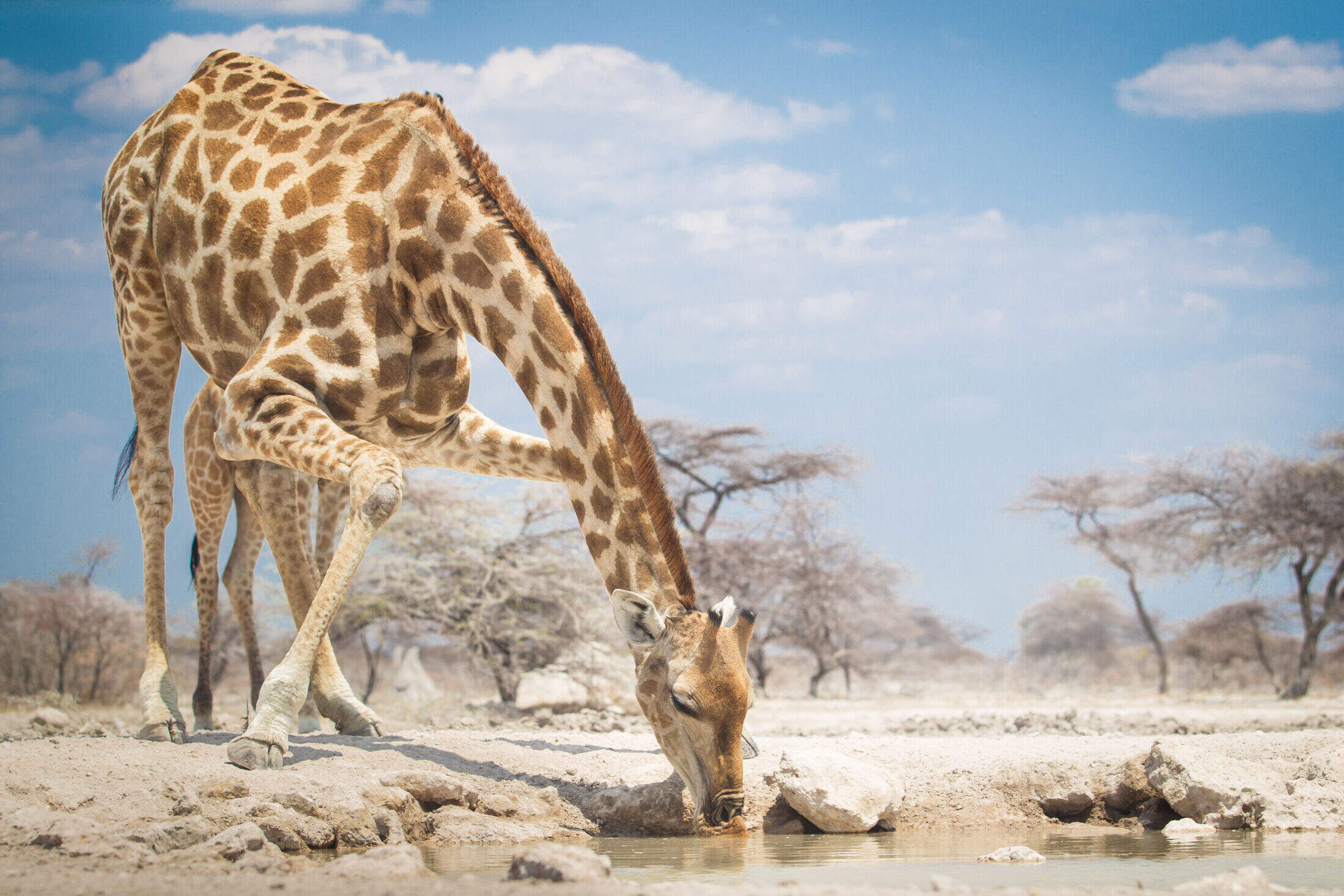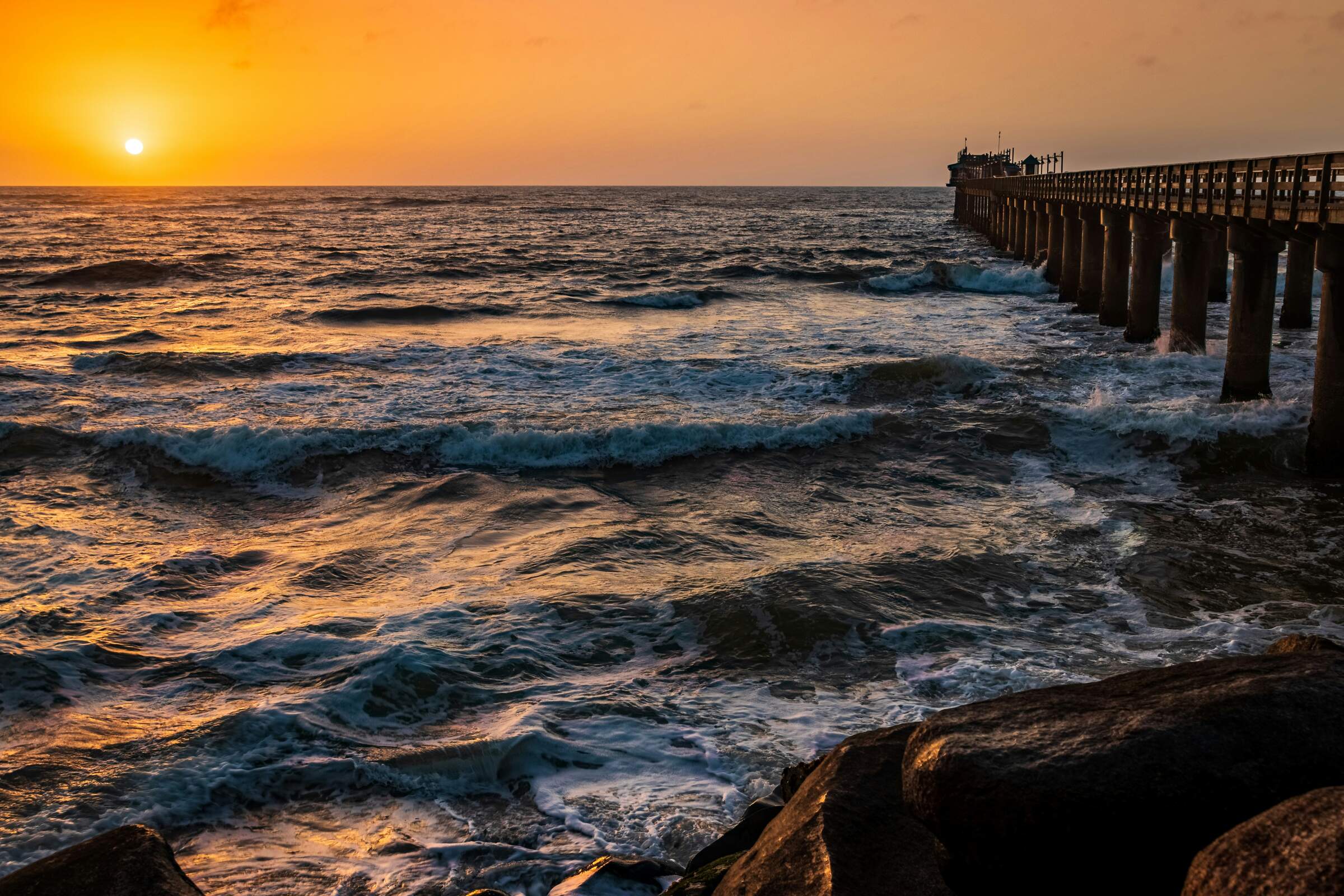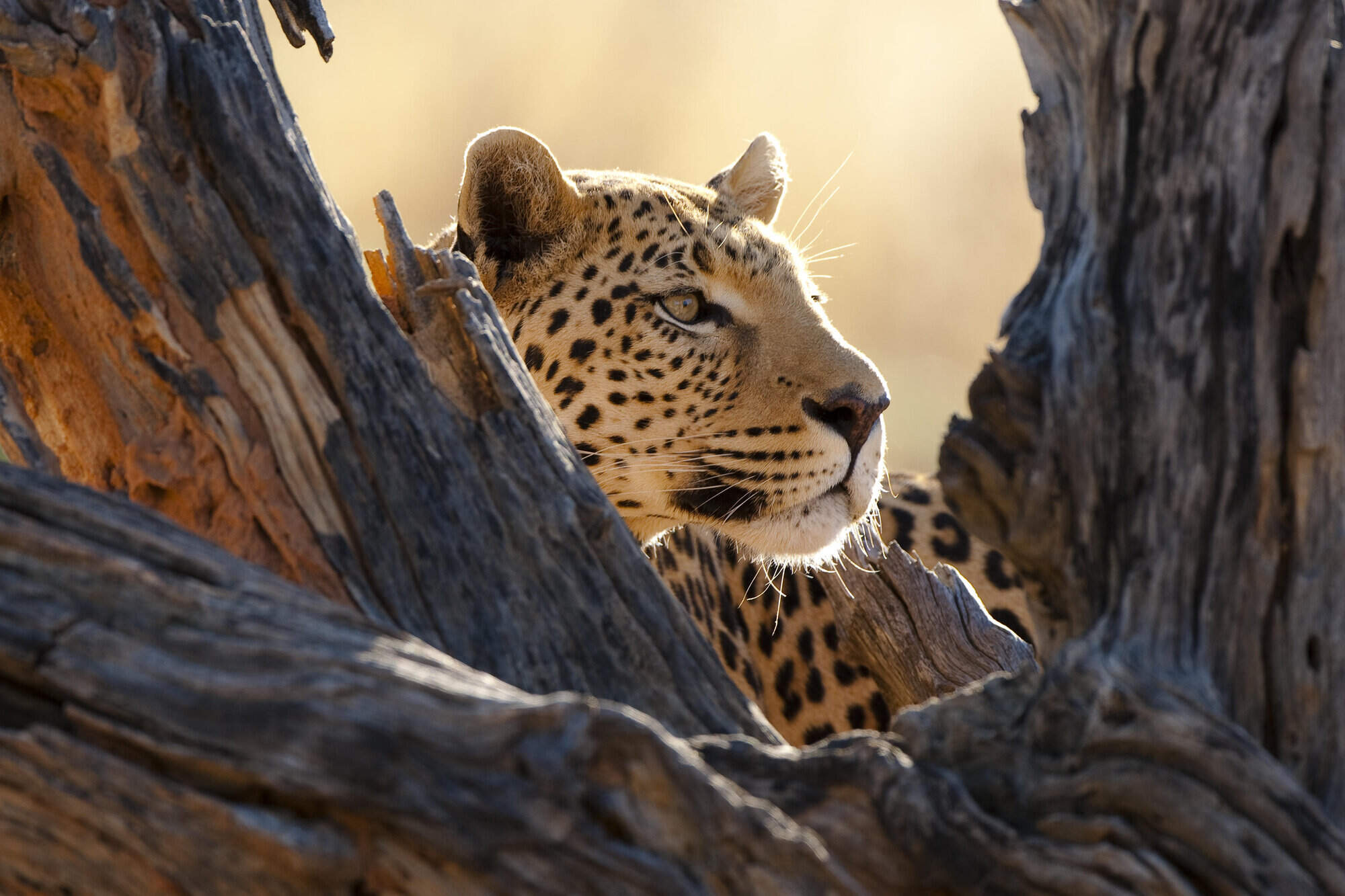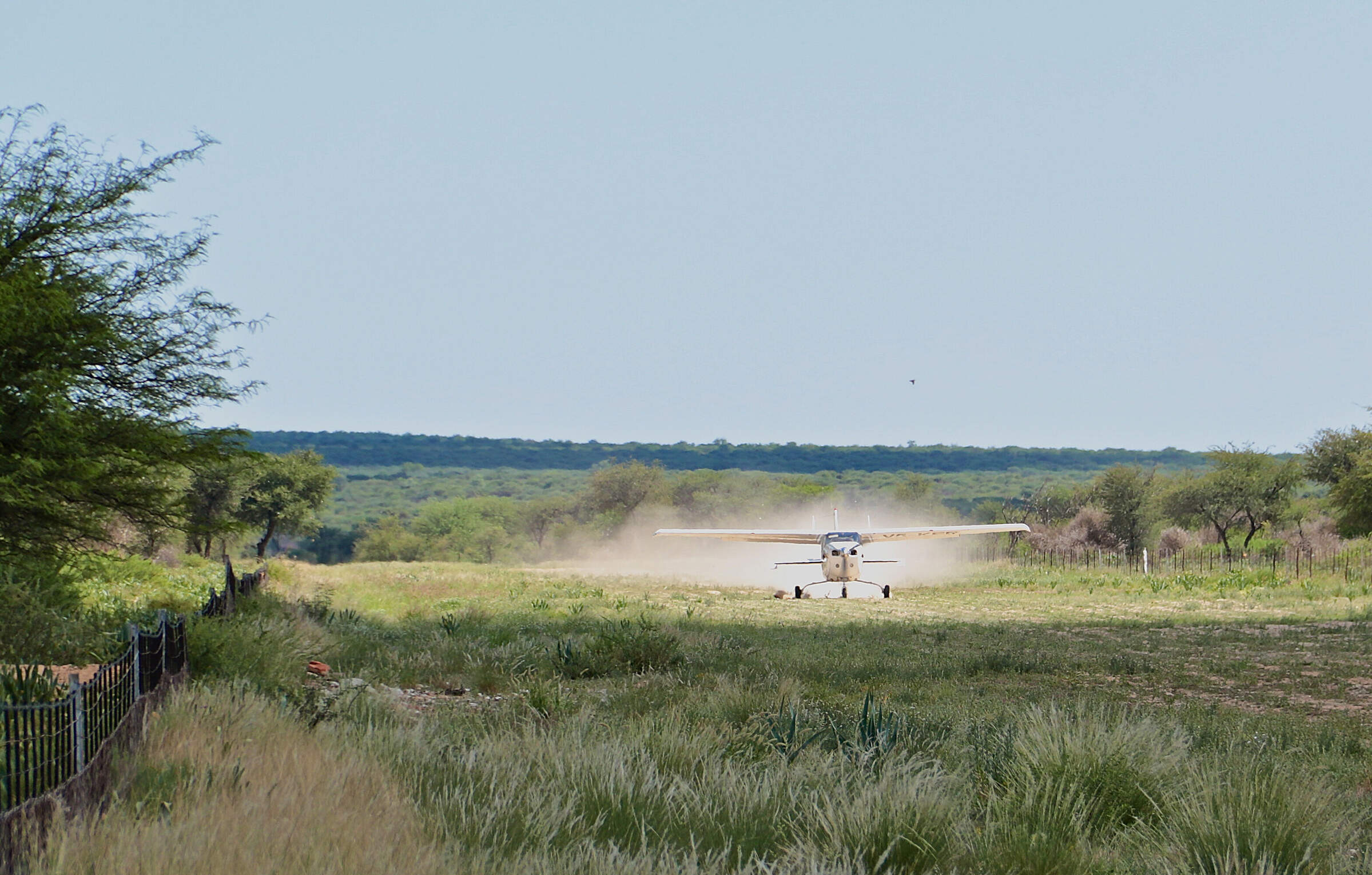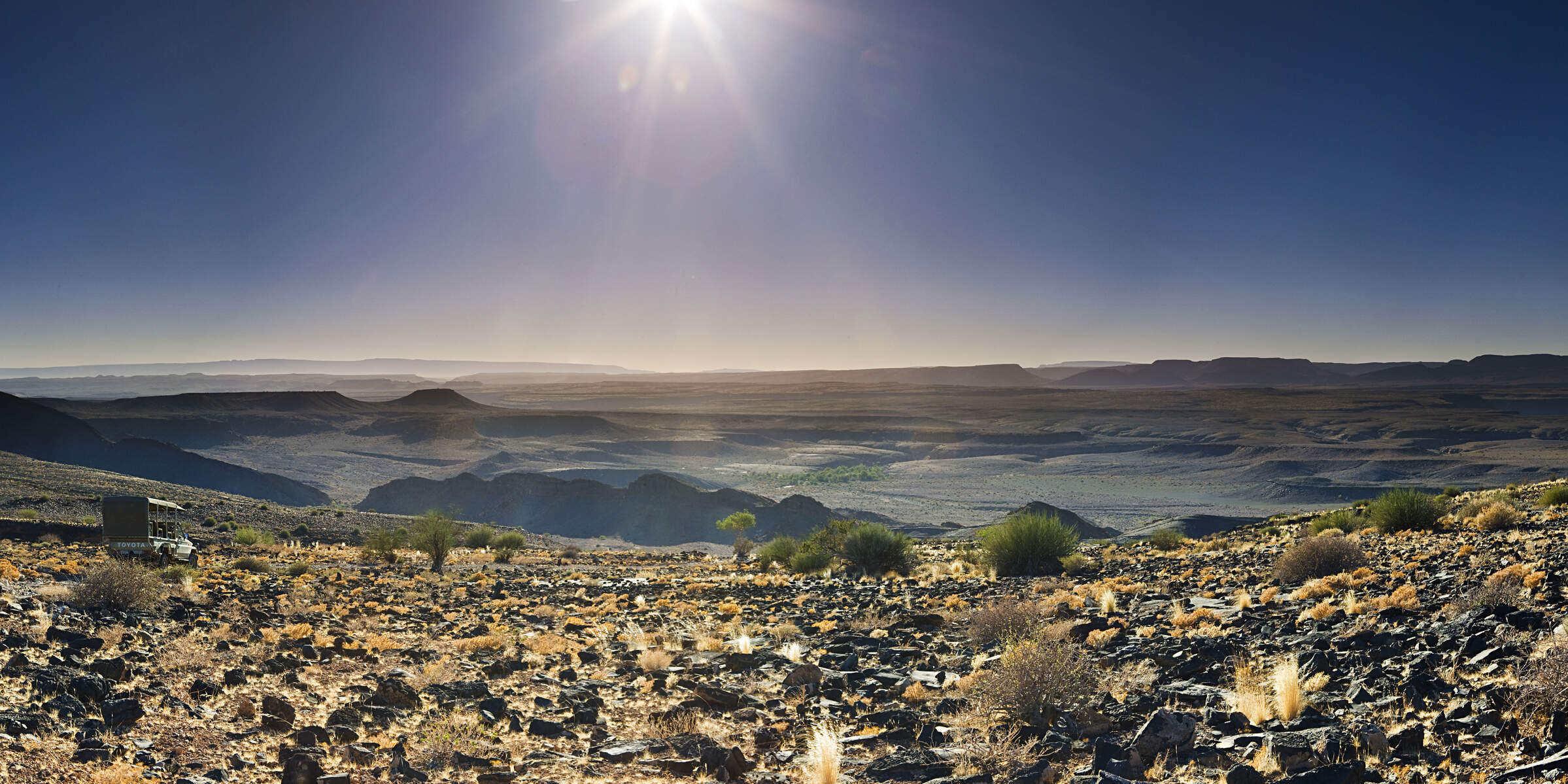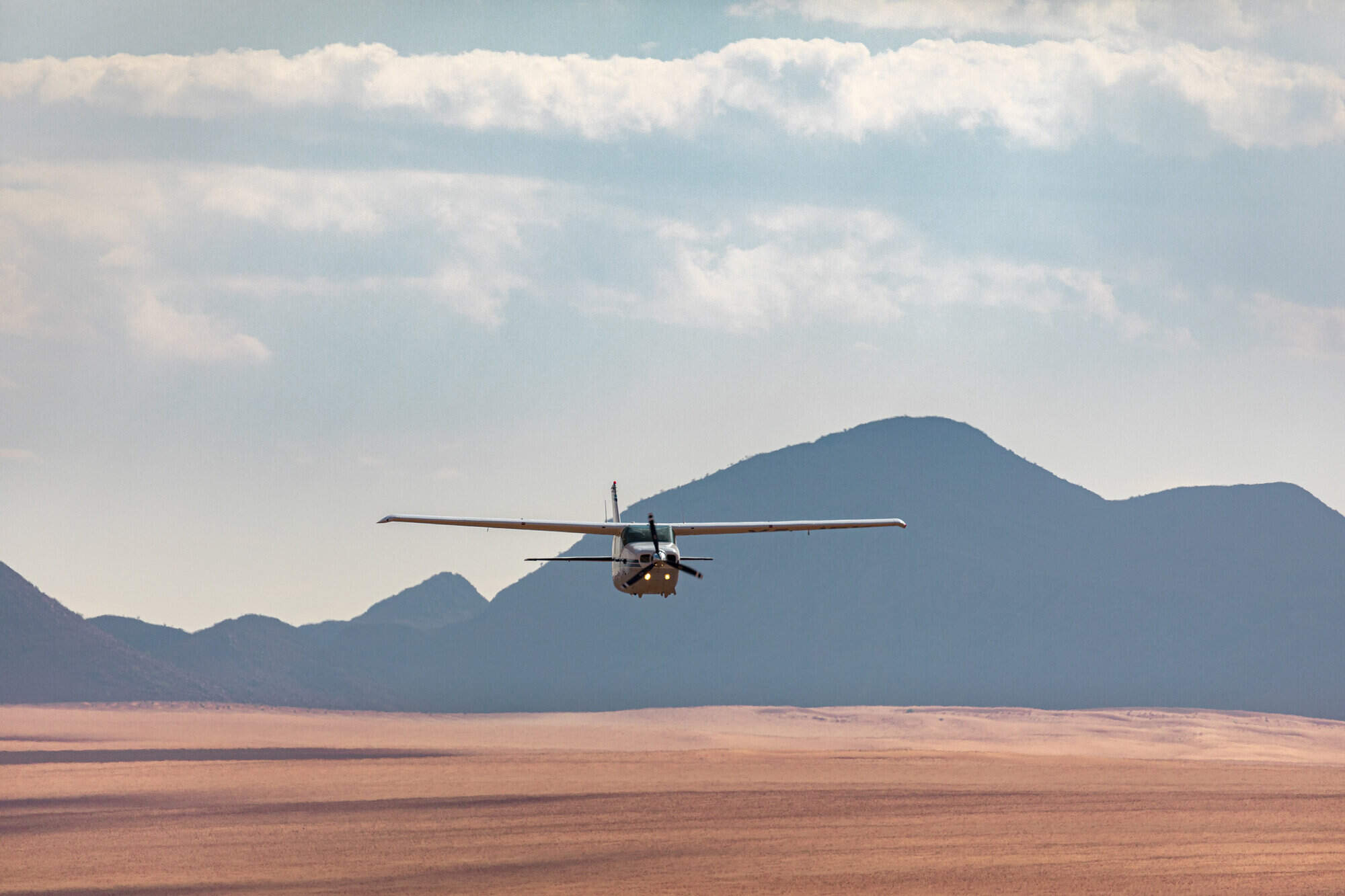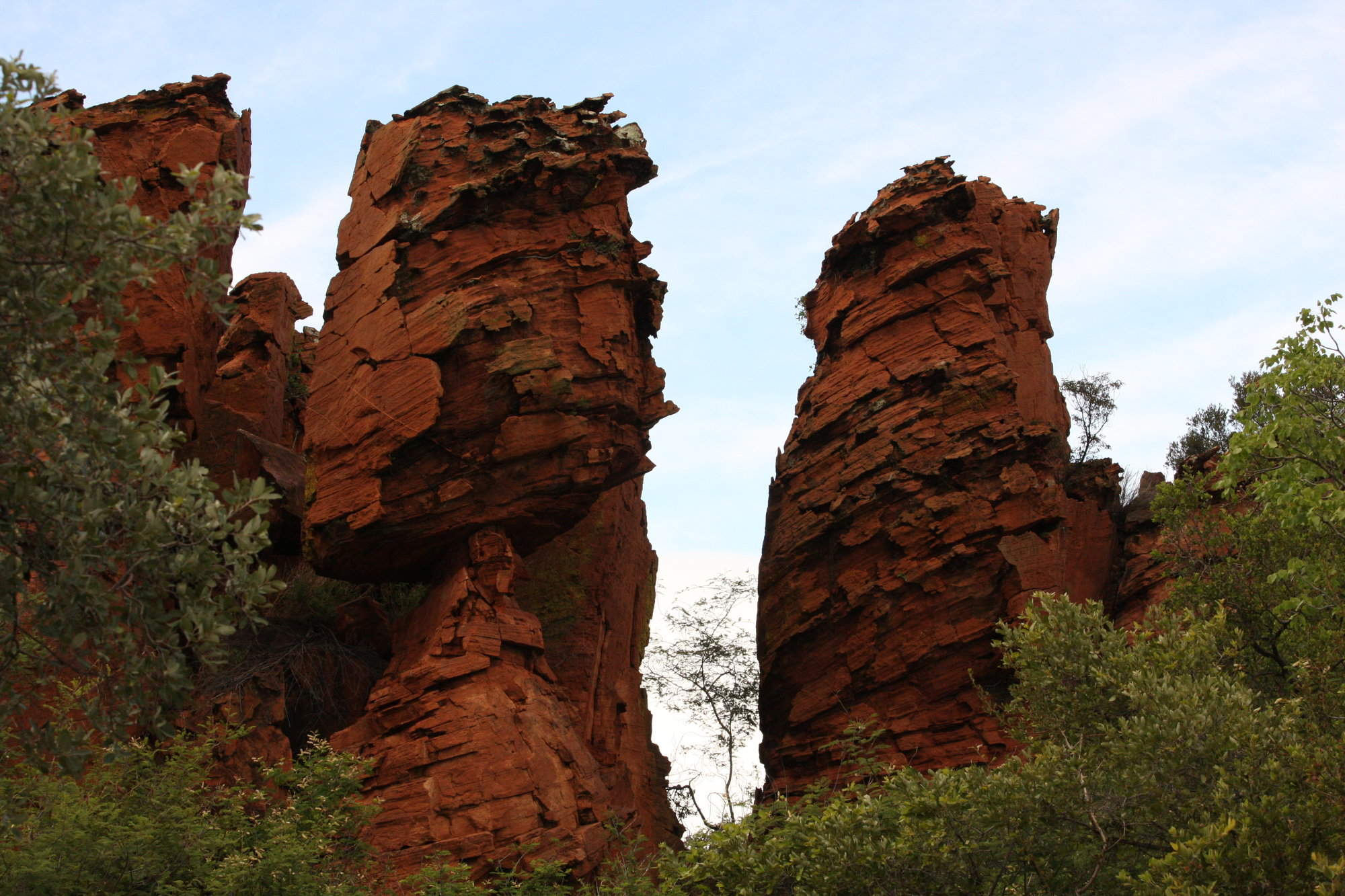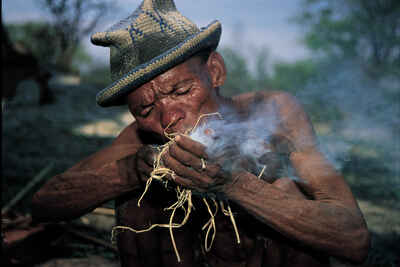
Bushmanland, the remote northern Kalahari
game viewing in the thickly wooded Khaudum
... visit small, traditional villages…
… witness their tracking skills
interact with the local people...
Bushmanland
Bushmanland
Sitting on the sand, I’m struck by how welcome I feel among these women as they settle down to work.
Small children wander around; the buzz of chat is accompanied by the occasional giggle at my attempts to shape the ostrich-shell beads; there is no ceremony.
Thanks to the interest of a trickle of visitors, the near-legendary skills of the San, or Bushmen have gained a renewed purpose. Participation is the key, from making beads or bows, to seeking out medicinal plants or water sources: this is an exceptional opportunity to immerse yourself in a traditional culture.
And the trade-off is palpable. Marginalised by 20th-century “progress”, the Bushmen were in danger of losing their identity, and with it the skills passed down over millennia. Now, as the focus on conserving the environment has shifted, their unique understanding of and connection with the land is becoming increasingly valued.
Just how important that understanding is becomes clear as you head further east. Visit between May and October and – to the horizon and beyond – the near-uniform sand colour is punctuated by increasingly scrubby vegetation. Water is scarce, life-threateningly scarce; foraging for food is an essential life skill.
Come the end of the year, the challenges change. Heavy rains can make quagmires out of tracks, rendering them all but impassable. But there are pluses, too. Nyae Nyae Pan becomes a magnet for breeding flamingos and numerous other water birds, while in the far north, the wildlife of Khaudum National Park breathes a collective sigh of relief.
A magical world accessible only in the drier months as part of a 4WD expedition, Khaudum boasts oryx, giraffe, wild dog, even big herds of elephant – but come most of all for the wilderness, the sheer scale of the place, perhaps to sleep under the stars – and let the wildlife be a bonus.

Self-drive trips including Bushmanland
To get the most out of your visit, drive yourself to Bushmanland and stay for at least three nights. Below is an example of how this can work:

Hartebeest Self-drive Safari
16 days • 8 locations
WINDHOEK AIRPORT TO WINDHOEK AIRPORT
This self-drive safari focuses on the best cultural experiences in Namibia. Visit a Himba village and enjoy three days living with the San Bushmen interspersed with some excellent wildlife watching.
US$4,430 - US$4,690 per person
Most recent reviews of our safaris to Bushmanland
Click below to browse all 42 reviews from Bushmanland. All from our travellers; all are in full & unedited.
Arrived 22 Sep 2024, 16 nights
"My September 2024 trip to Namibia"
Overall rating: Excellent
Arrived 27 Aug 2023, 20 nights
"My Aug 2023 trip"
Overall rating: Excellent
Arrived 13 May 2022, 21 nights
"My May 2022 trip"
Overall rating: Excellent
Arrived 20 Jan 2020, 19 nights
"Wonderful latest trip to Africa."
Overall rating: Excellent
Arrived 24 Sep 2019, 20 nights
"My Sep 2019 trip"
Overall rating: Excellent
Arrived 31 Jan 2017, 39 nights
"South Africa, Namibia & Botswana"
Overall rating: Excellent
Arrived 19 Sep 2016, 18 nights
"Another great holiday in wonderful Namibia"
Overall rating: Excellent
Arrived 25 Oct 2015, 11 nights
"My Oct 2015 trip"
Overall rating: Excellent
Arrived 19 Aug 2015, 15 nights
"Great Namibian holiday, would like to return"
Overall rating: Excellent
Arrived 23 Apr 2015, 19 nights
"One of our Best Trips Ever"
Overall rating: Excellent
Where to stay in Bushmanland
Mindful of the need for cultural sensitivity, we currently only recommend:
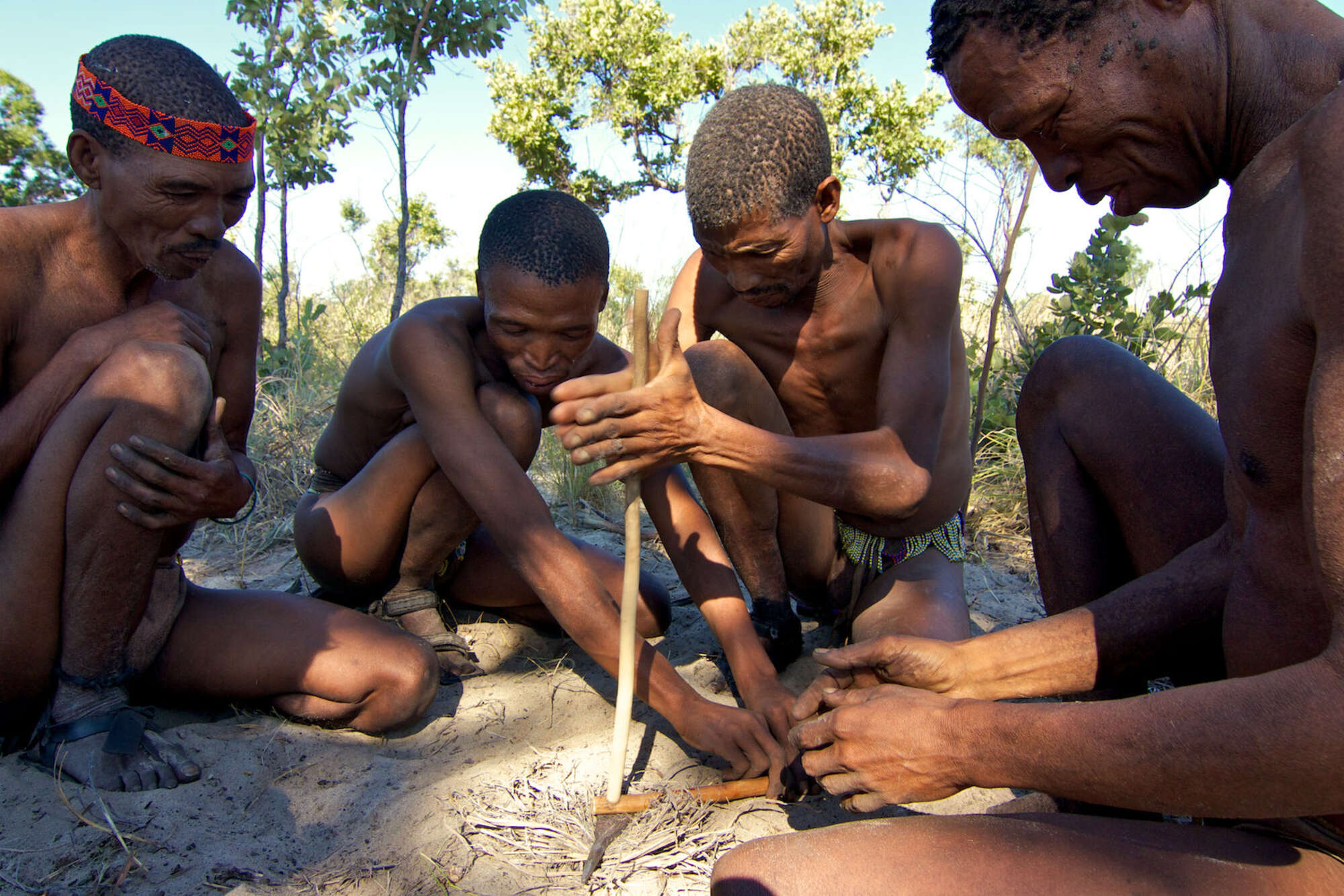
Nhoma Camp
Nhoma Camp offers a unique, sensitive and authentic introduction to a Bushman village and a true hunter-gatherer culture which is so different from our own.
Our travellers’ wildlife sightings in Bushmanland
There is plenty of wildlife in Bushmanland, but sightings are a bonus - as you'll see from our traveller's sightings records here.

60% success

60% success

60% success

40% success

40% success

40% success

20% success

20% success

20% success

20% success

0% success

0% success

0% success

0% success
When to go to Bushmanland
Our month by month guide: What it's like to visit Bushmanland in Namibia
Jan
Feb
Mar
Apr
May
Jun
Jul
Aug
Sep
Oct
Nov
Dec
Namibia in January
January is at the heart of Namibia’s rainy season. However, as you’d expect from a country dominated by desert and semi-desert environments, the rains are often (but not always) weak and usually quite localised. Some days will be clear, the strong sun raising temperatures to around 30ºC/86ºF; on others humidity and clouds build, sometimes culminating in spectacular thunderstorms. In extreme cases, these generate flash-floods which race down the beds of ephemeral rivers.
Across the country, the greening landscape makes a refreshing change, especially in desert areas. Many birds are in full breeding plumage and migrant species are here in force. In the north, where the rains are more reliable, the abundant water and food allows wildlife to disperse, making it trickier to spot.
- Variable weather: clear, hot & dry, or cloudy & humid with some rain
- Occasional, highly localised thunderstorms
- Many animals with young; birdlife at its most spectacular
- Wildlife dispersed & harder to see, especially in Etosha & the Caprivi
- Very few tourists (apart from the New Year) so rates mostly low
Our view
This is not a great time to visit
Weather in January
Namibia in February
February is the wettest month, but as Namibia is dominated by deserts, the rains are often weak and patchy. The variation in weather across Namibia is significant, too; the central highlands and Caprivi can see some heavy rain. More typically, some February days are clear with a hot, strong sun; others are cooler as cloudy skies build and, sometimes, culminate in short, spectacular thunderstorms. Occasionally these generate flash-floods, bringing ephemeral rivers to life and making travel more challenging.
Across the country, the landscape feels green and alive; insects and smaller animals are more easily seen, and many birds and animals are raising their young. However, small pools in the bush and thicker vegetation can make it hard to spot the wildlife.
- Variable weather: clear, hot & dry or cloudy & humid with some rain
- Occasional localised thunderstorms meander over the landscape
- The bush feels alive; birdlife is at its most spectacular
- Wildlife in Etosha & Caprivi is dispersed & harder to see
- Few tourists, so rates usually at their lowest
Our view
This is not a great time to visit
Weather in February
Namibia in March
March usually sees Namibia’s main rains tailing off, although actual precipitation varies hugely across the country and can be unpredictable from day to day. Many days will be clear, with a strong sun driving temperatures up. On others, clouds will build, and the late afternoon may see a short, spectacular thunderstorm. Such deluges reduce in both frequency and volume as the month progresses.
Across the country, landscapes are often vivid: a “green and pleasant land”. Many birds and animals are finishing raising their young, so smaller animals and insects are in evidence. In the north, where rains are generally heavier, pools in the bush and thicker vegetation can make it difficult to spot larger animals.
- Variable weather: clear, hot & dry or cloudy & humid with some rain
- Afternoon thunderstorms less common as March progresses
- Animals looking sleek and well-fed, after 3–4 months of plenty
- Wildlife in Etosha & Caprivi is dispersed & harder to see
- Few tourists visit during March, so rates often low
Our view
A good time to visit, with pros & cons
Weather in March
Namibia in April
Typically, April is dominated by dry weather; there’s an ever-decreasing chance of rain. Temperatures are now below their peak and continue to fall. Even so, days remain pleasant and warm, but there might be a slight chill in the air at night. The rains usually leave many parts of the country verdant and green, so animals are in fantastic condition – often with fast-growing young in attendance.
With the dust washed out of the atmosphere, photographers make the most of clear air, spectacular landscapes and healthy animals. Stargazers will have clearer night skies as the month progresses. In the game parks of Northern Namibia, water and food remain in plentiful supply, so finding big game can prove trickier than later in the year.
- Becoming drier &, especially at night, also cooler
- Few visitors, except around Easter, so rates remain low
- Wildlife in Etosha & Caprivi remains relatively hard to see
- Migrant birds have started to leave
- Fresh, clean air and often green, verdant landscapes
Our view
A good time to visit, with pros & cons
Weather in April
Namibia in May
By May, Namibia is usually drying out fast as the rains have ended. If they’ve been good, then the land remains green, but wildlife starts to congregate at more permanent water sources. Over much of the country the air quality and clarity can be amazing, making this an ideal month for photography.
Typical days are warm, with crisp, clear mornings and clear blue skies. Evenings are usually cool, and temperatures may dip below 10ºC (50ºF) overnight. Many lodges still charge “low season” prices, although with Namibia’s increasing popularity in recent years, some have started to introduce higher “shoulder season” rates.
May’s good-value rates, increasingly good wildlife sightings, beautiful landscapes and crystal-clear air combine to make this one of our favourite months in Namibia.
- Lovely weather: dry, warm days & cool nights
- The country is drying out although many landscapes remain green
- Fantastic air clarity – ideal for keen photographers
- Visitor numbers are often still low, mirrored by lodge rates
- Wildlife is starting to congregate more around remaining water
Our view
A very good time to visit
Weather in May
Namibia in June
Namibia is dry again. Skies are blue and usually largely cloudless. Days are lovely: warm and dry; nights are cold, sometimes below freezing in the desert. Most swimming pools in Namibia are always outdoors, making them too cold for all except the very dedicated.
Take a warm hat and gloves for game drives, where dawn and dusk will feel particularly chilly. In the north, especially Etosha, wildlife viewing is now into its dry-season pattern, focusing around the waterholes – though the park is still not busy.
Photographers come for superb air clarity, with minimal dust or smoke in the air. Historically, June rates have been low. However, with Namibia’s increasing popularity many lodges now count it amongst their “high-season” months, and request higher prices.
- Clear, bright days with blue skies; cold nights, mornings & evenings
- Great air quality, especially welcome for photographers
- “Shoulder season” for some lodges: lodge rates moderate
- Wildlife gravitates to waterholes, making game-viewing productive
- Some greenery in the landscape, depending on the last rains
Our view
A very good time to visit
Weather in June
Namibia in July
Reliably warm daytime temperatures (upwards of 20ºC/70ºF) and good wildlife sightings make this a popular month to visit Namibia. Rain would be very unusual indeed and clear skies make for great photographs. Once the sun sets, though, temperatures cool rapidly bringing cold nights that may dip below freezing in the desert. Be prepared: dress in layers and expect early-morning and late-afternoon drives, and anywhere coastal, to be cold.
As the land dries and vegetation shrivels, game congregates beside drinking water: Etosha’s waterholes are busy with animals. Across the country, lodges charge “high season” rates; many are fully booked a year or more in advance, especially during European school holidays (from the latter half of July to late August).
- Dry days, warm in the sun, with crisp, cold nights
- Cloudless skies: July is usually superb for stargazing
- The beginning of European school holidays so more families travelling
- Peak season: so high rates and many lodges fully booked far in advance
- A fantastic time of year for wildlife watching, particularly in Etosha
Our view
A very good time to visit
Weather in July
Namibia in August
August is the height of Namibia’s “winter”. Expect cloudless skies and plenty of warm sun in the day, but nights down to freezing in the desert. Dress in layers and bring warm clothes (including hats and gloves) for chilly starts and evenings. Only the hardiest even contemplate using outdoor pools.
It’s 3–4 months since any rain, so the land is dust-dry and much vegetation is golden brown. Many landscapes appear sparse and harsh. Wildlife congregates around available water sources, helping to guarantee good animal sightings.
Namibia is never really “busy” by the standards of Europe or the USA, but August is the most popular time to visit, especially for families. Book early (over a year in advance) if you want to stay at the best lodges.
- Dry days, warm in the sun; cold mornings, evenings & nights
- Cloudless skies in the day; spectacular stars at night
- Busy by Namibian standards: family rooms in particular demand
- Peak season: so high rates and many lodges fully booked far in advance
- A fantastic time of year for wildlife watching, particularly in Etosha
Our view
Fantastic: the very best time to visit
Weather in August
Namibia in September
September is a month of blue, cloudless skies and fantastic wildlife viewing. Rain is almost unheard of. As the month progresses, the days and nights get warmer. In some areas, daily maximums hit around the low 30s Celsius, although low humidity ensures this feels comfortable. The contrast makes the nights seem very cold. The air is becoming dustier, occasionally augmented by smoke from fires – so becoming hazy for photographic purists.
In the national parks, animals congregate around remaining water sources – making September one of the best months for game viewing. Hence it’s one of Namibia’s most popular months for visitors: a “high season” month that is often the time of choice for safari aficionados.
- One of the best months for wildlife viewing
- Warm days & cold nights, with temperatures rising during the month
- Many plants have faded from green to golden brown
- Air can be hazy – with dust & sometimes smoke
- High season rates; many lodges & camps are full 9 months in advance.
Our view
Fantastic: the very best time to visit
Weather in September
Namibia in October
Namibia is usually at its hottest and driest in October. Temperatures build as the month progresses; towards the end, daily highs may exceed 40ºC/100ºF, though with humidity close to zero, even this rarely feels oppressive.
In exceptional years, isolated rain showers may fall in late October. More usually, the end of the dry season sees wildlife watching at its best, particularly in Etosha. The place feels like a desert as spectacular herds of thirsty animals gather around the available water. October is popular amongst wildlife enthusiasts and commands peak-season prices, even if dust and smoke may make the air hazy, challenging photographers. Visitor numbers can fade towards the end of the month, allowing a window for last-minute bookings.
- Probably the most spectacular month for wildlife-viewing in Etosha
- Hot and dry: much of the country feels like a desert
- The air can be hazy with dust & smoke
- It’s peak time to visit, so expect high season rates
- Lodges & camps are full, especially early in October
Our view
A very good time to visit
Weather in October
Namibia in November
November is always a bit unpredictable: sometimes dry and hot; sometimes cloudier and cooler. Typically, mornings are hot and cloudless and clouds appear in the afternoon. Humidity builds and eventually breaks, resulting in spectacular thunderstorms that bring convection rainfall in late afternoons. Such storms are typically sparsely distributed and highly local – being completely absent from desert areas, for example. Places that do get good rain will flush green, with a tangible feeling of new life softening the landscapes. Many mammals give birth to their young.
Once any rains come, wildlife dissipates in search of food, and game viewing in Etosha becomes harder. Conversely, this is a great time for birdwatchers, with migrant species in breeding plumage.
- A very interesting, variable month, depending on the rains
- With rains come an amazing explosion of both vegetation & new life
- Wildlife viewing better in Damaraland than Etosha if it has rained
- Shoulder season: mid-range rates offer great value
- Away from the Namib, showers are more likely later in the month
Our view
A good time to visit, with pros & cons
Weather in November
Namibia in December
December is the first “proper” month of Namibia’s rainy season, and one of its hottest. Clear mornings give way to building clouds and, with luck, the occasional short, spectacular thunderstorm: refreshing and cleansing. These are often highly localised and generally warmly welcomed: most Namibians love rain!
Rains clear the air of dust. Even relatively short showers enable plant life to erupt, carpeting this thirstland in green and providing food for the young animals which abound. Animals disperse widely, which can make game viewing challenging. Many birds are breeding and so sporting their most colourful plumage.
Christmas and the New Year fall within local “summer holidays” – so places to stay can be surprisingly busy, especially in and around coastal towns, where temperatures are cooler.
- Hot and humid; sometimes refreshed by cooling showers
- Landscapes flushed green if/where there has been rain
- A tangible life and energy amidst this often green & pleasant land
- Very photogenic: blooming deserts amidst crystal-clear air
- Best time for birdwatchers; larger animals harder to spot
Our view
This is not a great time to visit
Weather in December
Bushmanland: In detail
Bushmanland
East of Etosha, four hours' drive by saloon car from the outpost town of Grootfontein, there's a remote region of the northern Kalahari known as Bushmanland. (This is an old name, which we use here for clarity; it remains what most people call the area.)
Drive east towards Tsumkwe, and you're driving straight into the Kalahari. On their first trip here, people are often struck by just how green and vegetated it is, generally in contrast to their mental image of a “desert”. In fact, the Kalahari isn't a classic desert at all; it's a fossil desert. It is an immense sandsheet which was once a desert, but now gets far too much rainfall to be classed as a desert.
Look around you and you'll realise that most of the Kalahari is covered in a thin, mixed bush with a fairly low canopy height, dotted with occasional larger trees. Beneath this is a fairly sparse ground-covering of smaller bushes, grasses and herbs. There are no spectacular sand dunes; you need to return west to the Namib for those!
The people: the San or Bushmen villagers
The conventional view is that less than a century ago these people's ancestors were a traditional hunter-gatherer society using Stone Age technology. Yet they possessed a knowledge of their environment that we are only just beginning to understand.
Because their understanding of their natural environment is amazing to witness, and their survival skills are beyond belief for many Westerners, tourism is increasingly seen as a vital source of revenue for these people. In placing a high value on traditional skills and knowledge, it is hoped that it will help to stem the erosion of their cultural heritage.
Wildlife in Bushmanland
Sights to see in Bushmanland
Nyae Nyae Pan
Aside from coming to Bushmanland out of a general curiosity about the area's wildlife and culture, one area stands out: the Nyae Nyae Pan. About 18km south of Tsumkwe, this is a large complex of beautiful saltpans, each surrounded by grass that can grow to 60cm tall and a belt of tall trees beyond. During good rains the pans fill with water and attract breeding flamingos, as well as dozens of other waterbirds including avocets, pygmy geese, grebes, various pipers and numerous plovers. Forty-six different species of waterbirds have been recorded here when the pans are full.
Towards the end of the dry season you can normally expect to see game drinking here. Regulars include kudu, gemsbok, steenbok, duiker and elephant, with black-backed jackals on constant patrol.
Aha Hills
Southeast of Tsumkwe is an isolated group of hills straddling the border between Botswana and Namibia: the Aha Hills. Named, it's claimed, after the onomatopoeic call of the barking geckos that are so common in the area, these are remote enough to have a certain mystique about them – like their counterparts entirely in Botswana, the Tsodilo Hills.
However, there the similarity ends. The Aha Hills are much lower and more flattened. Their rock structure is totally different: a series of sharp, angular boulders quite unlike the smooth, solid massifs of Tsodilo. So they are quite tricky to climb, and have no known rock art or convenient natural springs. All of this means that though they're interesting, and worth a visit if you're in the area – they do not have the attraction of Botswana's Tsodilo Hills.
Khaudum National Park
Wildlife in Khaudum National Park
The game is wild and the atmosphere magical. There are large herds of elephant plus tsessebe, red hartebeest, blue wildebeest, kudu, oryx, giraffe and good numbers of the uncommon roan antelope. The main predators are spotted hyena, lion, leopard and wild dog (Khaudum is the centre for Namibia's population of these rare predators). However, come here to experience a wilderness in a very remote corner of the Kalahari; let game sightings be a bonus.
A Note on Responsible Travel
However, in Nhoma Camp we have great confidence. We know that the money the villagers earn from our travellers' visits has, over the years, made huge positive impacts on their lives; tourism has significantly helped the whole village. It has also increased the value that the people place on their own traditional skills and culture – as they now see these skills as a passport to earning money, rather than an anachronism.
Map of Bushmanland
Choices for where to stay in Bushmanland
Bushmanland: Safaris

Hartebeest Self-drive Safari
16 days • 8 locations
WINDHOEK AIRPORT TO WINDHOEK AIRPORT
This self-drive safari focuses on the best cultural experiences in Namibia. Visit a Himba village and enjoy three days living with the San Bushmen interspersed with some excellent wildlife watching.
US$4,430 - US$4,690 per person
Our best 1 lodges and safari camps in Bushmanland
There are several basic campsites within the Nyae Nyae Conservancy, where you’ll find a place to camp for which you pay the nearby community directly.

Nhoma Camp
Nhoma Camp offers a unique, sensitive and authentic introduction to a Bushman village and a true hunter-gatherer culture which is so different from our own.

Looking for inspiration on where to travel next?
Visit our trip chooser to explore your options and find inspiration for your perfect African adventure
Inspire me